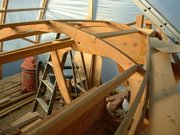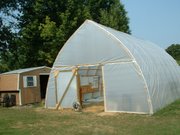Sailboats Fair and Fine # 30 : read oldest posts first
The bottom Picture is a U.S. Army tug aground in about seven feet of water. That thing must be deep draft. Sadly, She's the only south bound boat we passed today.The picture above it is the anchorage at Swansboro and out in front of Caspers Marina. "Nice people."
Oct.23
We left early, about 6:30,and put in a very long day. We dropped Anchor about 25miles down the waterway. It started out to be a very nice day and the weather was really nice. As we were going through the swing bridge at Moorehead city, another boat passed us-- “Gimbi” from Biloxi. The captain called to us, “ Lets go back to Deltaville.”We smiled and waved to each other. Doug and I didn't remember the boat but evidently they had been in Deltaville when we were there. Maybe we'll see them again as we get farther south. The way it looks that's going to be a while. All day long, boats have been passing us going south on the ICW. We thought it was just because the wind was against us but this evening we found out the clutch has been slipping all day and has finally burned up. We turned around and with the wind with us we sailed back about 3 miles and anchored in front of a marina in Swansboro, N.C.
The next few days will be big ones. For a little background on the coming events let me say that as a small kid I had some experience with clutches. My father who was a builder of all manner of things built a garden tractor. For an engine he used a Model T ford engine with it's transmition. I hung over his shoulder and watched handing him tools, but most generally getting in his way. I learned a lesson when I asked a question and he begun to answer. It always took him a lot of time to think over the question and come up with a good answer for a small boy. I asked another question on another subject before he could answer and he lost his patience and said, "Boy when you ask a question If you want to know the answer keep your mouth shut so it can be answered. If you done really want to know don't ask. Now do you want to know or not." "Yes," I replied, and then got my answer.
What this all boils down to is this. The little little Yanmar engine has a small version of the model T Ford clutch on it. So I already knew a lot about rebuilding it right from the start.
While I'm at it, it may be helpful to some to know that the big hydrolic clutches on marine engines are the same clutch with a hydrolic pump to generate the pressure to hold the plates tight together to transmit power to the propeller shaft. Don't let those high techy types tell you you need to go to college to fix one. Seventy five years ago every man in America could take one apart and fix it.










